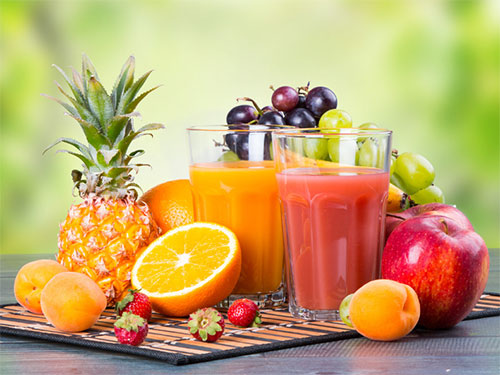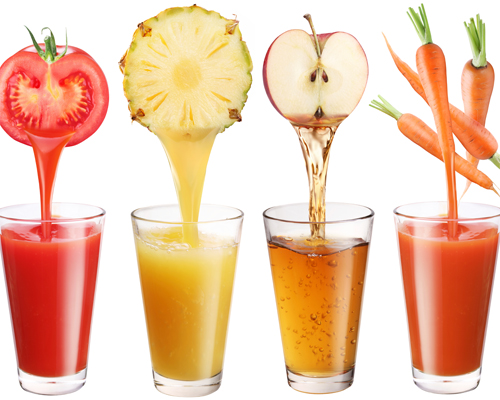
Fact Sheet FS542

Health experts agree that eating plenty of fruits and vegetables is key to lowering your risk of developing chronic diseases, including certain cancers and cardiovascular disease. Yet, it can be difficult to figure out how much of a role fruit and vegetable juices should play in a healthy diet. While it's fine to make a place in your diet for juices, it's important to do your homework, shop carefully and choose wisely.
Weighing the Pros...
Fruits and vegetables contain a wide range of vitamins, minerals, fiber and phytonutrients that experts agree promote health and protect against chronic disease. Except for the fiber, fruit and vegetable juices can contain similar levels of the same nutrients as their whole fruit and vegetable counterparts.
Fruit and vegetable juices are good sources of antioxidants and phytonutrients. The terms "phytonutrient" and "phytochemical" are used to describe those plant compounds that are thought to have antioxidant, immune boosting and other healthprotecting qualities. Phytonutrients include terpenes, carotenoids, limonoids, phytosterols and others.
Processing does affect the levels, bioavailablility and activity of phytonutrients and antioxidants in juices—but not always in a bad way. Apple juice, for example, loses most of the apple's antioxidant activity because the most nutrient-dense part of the apples is not used to make the juice...it's thrown away. The lycopene in tomato juice, on the other hand, is more bioavailable than in a fresh tomato, thanks to the heat and oil used to produce juice. Even hand squeezing makes a difference. Commercially squeezed orange juice and pomegranate juice contain more phytonutrients and antioxidants, respectively, than their hand-squeezed counterparts.
...Considering the Cons
Juices are more calorie-dense and are a more concentrated source of simple sugars than whole fruits and vegetables…an important distinction. Juices also have less fiber and can be more expensive per serving than fruits and vegetables. High consumption of juice is linked to weight gain in some studies—but not in others. Still, health professionals recommend moderation. It's easier to add extra calories with juice than with whole fruits or vegetables, simply because you can drink, say, two glasses of orange juice more quickly than enjoying a single orange.
Similarly, those who take anti-blood clotting medications must be cautious of drinking too much juice that is prepared from foods rich in vitamin K (such as spinach and kale) to avoid food-medication interactions. Consumers with health conditions such as kidney disease, hypertension or diabetes should discuss the role of fruit juice in their daily meal plans with a physician and registered dietitian (RD).
Navigating the Juice Jungle
Juice products fall into three major categories:
- 100% Juices – 100% juice is either squeezed directly from the fruit or made from concentrated juice that is reconstituted with water. It includes no added sugars, sweeteners, colors or additives. (Although, it is often supplemented with vitamins and or minerals…) This includes both single- or multiple-fruit combinations, such as orange or orange-passion.
- Juice Drinks – A variety of juice beverages are made by blending juice with other ingredients/additives. Juice drinks contain less than 100% fruit juice. The juice content in these drinks can range from about 10% to less than 100%; and, they can contain added sweeteners, flavors and other additives. Juice drinks are also identified as juice cocktails, juice blends, fruit "-ade" or some other term meant to indicate that they are not 100% juices. They may have the same amount of calories per serving as 100% fruit juice, but the phytonutrient, vitamin and mineral content of juice drinks won't equal what you get from their 100% juice counterparts. While they can legally range from more than 0% to less than 100% juice, juice drinks generally contain about 10% to 50% juice.
- Fruit-Flavored Drinks – Fruit-flavored drinks contain no fruit juices and use sweeteners and flavorings to give them their fruity flavors. While they're often fortified with vitamins and minerals to look nutritious, they're missing the antioxidants and phytochemicals found in actual fruit and vegetable juices. They're also high in "free sugars," which groups such as the World Health Organization and the United Nations Food and Agriculture Organization urge consumers to limit.
Is a Juice Just a Juice?
Whether you're buying a new car or a bottle of juice, it's important to know what you're getting for your money. Look for 100% fruit juice, but don't stop there. Some 100% juices are nutritionally superior to others, just as some fruits and vegetables are nutritionally superior to others. Read the food label and select more nutrient-dense juices…juices with higher percentages of vitamins and minerals, like Vitamins A and C and folate. Consider juices fortified with calcium and vitamin D, as well, to support healthy bones.
Know exactly which juices are used to make the product you buy by reading the ingredient list. Ingredients are listed from the most to least abundant on the ingredient list. If your 100% fruit juice lists apple juice as the first ingredient and pomegranate as the last, you're drinking much less pomegranate juice and mostly apple juice. Consequently, you won't reap the phytonutrient benefits that make pomegranates so appealing.
If you're juicing your own fruits and vegetables, experts recommend using a 3:1 vegetable-to-fruit ratio to maximize nutrients and flavor. Choose recipes that use nutrient-dense vegetables and fruits like kale, spinach, beet, bell pepper and citrus, and strive for colorful juice recipes, particularly red and green.
All juices contain water and sugar. If you're drinking 100% juice, the sugar is naturally occurring fructose. Juice drinks, on the other hand, are made with added sugars like high-fructose corn syrup. While your body won't differentiate between added and naturally occurring sugars, there may be more sugar and, consequently, more calories in juice drinks, depending on the amount of added sugar.
Picking a Quality Juice
Including "quality" juices in your diet can be a healthy part of achieving your fruit and vegetable goals. But…just what is a "quality" juice? Depending on the fruits or vegetables they're made from, juices supply varying amounts of nutrients. Many juices contain little more than sugar and water. Others offer the same vitamins, minerals, and many of the same phytochemicals (although not the fiber) found in their corresponding fruit or vegetable.
Both the medical and nutrition communities agree that a "quality" juice is one that is 100% juice, as opposed to juice drinks or blends that contain less than 100% juice. Experts also agree that you should limit the amount of juice you drink – even if it is 100% juice. Both the American Academy of Pediatrics and the Academy of Nutrition and Dietetics recommend that juice should be substituted for no more than one of the 5+ recommended daily servings of fruits and vegetables. (One juice serving is about 8 ounces for an adult, 4–6 ounces for a young child.) Both groups point out that juices lack the fiber and are higher in simple sugars than their whole fruit counterparts.
When considering the health benefits we typically associate with fruits and vegetables – protection against certain cancers and cardiovascular disease—enjoying a glass of OJ with your breakfast cereal or adding a can of vegetable juice to your lunch box could be a convenient way to include fruits and vegetables in your diet. And, these days, juices are often fortified with vitamins and minerals such as vitamin C and calcium to enhance their nutritional profile. The key, however, is to balance juice with fruits and vegetables:
- Eat a variety of whole fruits, vegetables and juices.
- Select a colorful assortment of fruits, vegetables and juices to get an assortment of phytonutrients.
- One daily serving of juice is a good start toward meeting your daily fruit and vegetable goals. But don't be fooled; juices offer no real nutritional benefits over whole fruits and vegetables. They're a tasty change but not a substitute for the "real thing."
Use these tips and our chart and you'll be off to a good start!
- Check the Label – Manufacturers are required by law to declare the juice percentage by the words, "Contains __% ___ juice" or "___% juice." Make sure the juice you're buying is 100% juice.
- The More Colorful, the Better – The greatest number of healthful phytonutrients can be found in the most colorful foods. This is true of juice, as well. Virtually all 100% juices contain something worth recommending. Those with more color to them, however, tend to have more antioxidants, phytochemicals, vitamins and minerals. Pink grapefruit juice gives you the antioxidants lycopene and beta-carotene, which are missing from white grapefruit juice. Purple grape juice packs a more potent antioxidant punch than white grape juice.
- Consider Your Own Special Needs – For adults, the phytochemicals and antioxidants in purple grape juice offer protection against cancer and heart disease. For children, the vitamin C and folate in orange juice make it a better choice to support growth, development and immune function. If you're prone to urinary tract infections (UTIs), the tannins in cranberry juice inhibit E. coli bacteria from adhering to the walls of the bladder and urethra, preventing them from hanging around to cause infections. The tannins are powerful protectors. (Dried cranberries are just as effective per serving as juice in preventing UTIs and, unlike juice, they contain fiber as well.)
- Weigh the Good and the Not-So-Good – There are advantages and disadvantages to everything we choose. Sometimes these contrasts are apparent; others they are not. Prune juice, for example, is one of the most phytochemical-rich juices you can purchase. It's also rich in sorbitol, a natural sugar that soaks up water, making prune juice a superb bulking agent with a well-known laxative effect. Apple juice and white grape juice, on the other hand, are sorbital-rich juices that can have similar laxative effects as prune juice, yet they are not stereotyped as such.
- Add Up the "Extras" – Fortification has the potential to make a good juice even better. 100% juice with added calcium and vitamin D has proved to be an excellent way to supplement calcium for bone building and prevention of osteoporosis. The verdict may not be as complimentary for juices that contain higher doses of vitamins and minerals.
- Be Safe – Read labels and select only pasteurized juices and ciders. When shopping at farm markets, ask if juice/cider is pasteurized if the label doesn't indicate it. Unpasteurized juice and cider may contain pathogens like E. coli, salmonella and cryptosproidium. While most people's immune systems can usually fight off the effects of foodborne illness, children, the elderly, pregnant women and people with weakened immune systems risk serious illnesses or even death from drinking untreated juices/cider.
- If you're juicing your own fruits and vegetables, start by washing fruits and vegetables thoroughly. Fresh juice can quickly develop harmful pathogens, so only make as much as you can drink immediately.
- Balance Juice with Fruits and Vegetables – Don't be fooled; juices offer no real nutritional benefits over whole fruits and vegetables. They're a tasty change but not a substitute for the "real thing." One serving of juice is a good start toward meeting your daily fruit/vegetable goals.
Fruit Juice & Children
Is fruit juice dangerous for children? In reality, according to the American Academy of Pediatrics (AAP), there are many other more important dangers to your child's health, but drinking too much fruit juice can be a problem.
According to the AAP, drinking too much juice can contribute to obesity, the development of cavities (dental caries), diarrhea and other gastrointestinal problems, such as excessive gas, bloating and abdominal pain.
Among the recommendations of the AAP report, The Use and Misuse of Fruit Juice in Pediatrics, which are actually daily limits of how much fruit juice kids should drink, and not an actual recommendation to drink juice, are that:
- When you give your child juice, it should be 100% pasteurized fruit juice and not fruit drinks.
- Infants under 6 months of age should not be given juice, although many pediatricians do recommend small amounts of juice for children who are constipated.
- Infants between 6 and 12 months can drink up to 4–6 ounces of juice a day, but only in a cup, never in a bottle.
- Younger children aged 1 to 6 years should have only 4–6 ounces of juice a day; children aged 7 and older should be limited to 8–12 ounces of juice a day.
- Instead of juice, children should be encouraged to eat whole fruits.
| Juice | Vitamin A | Vitamin C | Potassium | Folate | Fiber | Phytochemicals | |
|---|---|---|---|---|---|---|---|
| Name | May Protect Against | ||||||
| Apple | - | - | - | - | - | Anthocyanins, Quercetin | Cancer, Heart Disease |
| Cranberry | - | *** | - | - | - | Anthocyanins, Tannins, Ellagic Acid | Cancer, Urinary Tract Infections |
| Grape (concord/purple) | - | - | - | - | - | Anthocyanins, Resveratrol | Cancer, Heart Disease |
| Grape (white) | - | - | - | - | - | Ellagic Acid | Cancer |
| Orange | - | *** | * | * | - | Hesperetin, Monoterpenes | Cancer, Heart Disease |
| Pineapple | - | ** | * | * | - | Bromelain | Arthritis |
| Pink Grapefruit | * | *** | * | - | - | Lycopene, Beta-Carotene | Cancer, Heart Disease |
| Prune | - | * | * | - | * | Anthocyanins | |
| Tangerine | * | *** | * | - | - | Monoterpenes, Lutein | Still under study |
| Carrot | *** | ** | * | - | - | Beta-Carotene | Cancer |
| Tomato | ** | *** | * | * | - | Lycopene, Beta-carotene | Cancer (In particular, prostate cancer), Heart Disease |
| Vegetable Juice (V-8) | *** | *** | * | * | - | Lycopene, Beta-carotene | Cancer (In particular, prostate cancer), Heart Disease |
Key: 8 ounces = *10–24% DV; **25–49% DV; ***50%+ DV
June 2013
Copyright © 2024 Rutgers, The State University of New Jersey. All rights reserved.
For more information: njaes.rutgers.edu.
Cooperating Agencies: Rutgers, The State University of New Jersey, U.S. Department of Agriculture, and Boards of County Commissioners. Rutgers Cooperative Extension, a unit of the Rutgers New Jersey Agricultural Experiment Station, is an equal opportunity program provider and employer.



